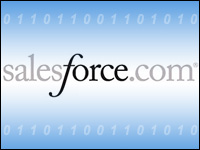
When one company is ousted from the S&P 500 index, another one is added to keep the number at 500. The most recent losers in this game of musical chairs are, for obvious reasons, Fannie Mae and Freddie Mac. Effective Sept. 12, these mortgage giants will be replaced by Fastenal and Salesforce.com, respectively.
For Salesforce.com — erstwhile upstart, now on-demand market maker with a market cap of US$6.8 billion — being invited to join this exclusive group of companies is a milestone that few other achievements can beat.
Salesforce.com was founded in the 1990s by former Oracle executive Marc Benioff, whose nonstop marketing and evangelizing efforts in the early days were arguably a major reason for the market’s acceptance of the Software as a Service model.
The company went public during a time when tech IPOs (initial public offerings) were anathema to Wall Street, and it has since revealed a go-to-market strategy that is far bigger than its customer relationship management roots. With the introduction of its AppExchange and Force.com, Salesforce.com is striving to deliver a platform on which companies can build any type of application.
Being added to the S&P Index “is a testament to the scale the company has achieved in such short order,” said Canaccord Adams’ Rich Baldry, who follows Salesforce.com.
“It is the first Software as a Service company to reach a $1 billion run rate,” he told CRM Buyer. “Only a handful of software and IT companies do $1 billion in any group, to say nothing of SaaS.”
The closest pureplay on-demand provider, said Baldry, is Omniture, a Web analytics software provider worth $300 million. There are three IT companies among the 10 largest in the S&P 500 index, based on market cap: Microsoft, IBM and Apple.
Q2 Earnings
For its second quarter, Salesforce.com’s most recent report period, the company posted sales of $263.1 million — a 49 percent jump in year-over-year growth that pushed the company over the $1 billion mark in annual sales. Earnings grew by 167 percent to $10 million; revenue rose 50 percent to $239.7 million.
In Q2, Salesforce.com alsoacquired InStranet for $31.5 million — a move that concerned Wall Street once the entire quarter’s earnings were revealed.
“Investors were slightly nervous about the acquisition, because it was responsible for a short-term moderate dilution” in revenue, Baldry said.
There were also concerns about deferred revenue growth, he continued. “That is challenging right now for the company, because its contracts tend to be skewed towards Q4 renewals.”
Still, Q2 was generally a stronger quarter than many had expected. “It was a breakout performance, really,” Baldry said, “as a record number of customers were added, and [it hit] the $1 billion revenue mark.”
The Index Effect
The Street exhibited few signs of skittishness over Salesforce.com on Wednesday: Its shares traded up $3.99 to close at $56.09.
The Street’s vote of confidence is hardly surprising, Frederic Ruffy, senior options strategist at WhatsTrading.com, told CRM Buyer. “The move signals that Standard & Poor’s committee in charge of the index deems Salesforce.com to be large and prominent enough to be included in the exclusive S&P 500.”
The gain in Salesforce.com’s share price is also due to a phenomenon known as the “Index Effect,” he added. “There are a large number of institutional funds and exchange-traded funds that try to mimic the performance of the S&P 500. Therefore, when news surfaces that a company is being added, these institutional funds are forced to buy the stock, and the surge in buying interest puts upward pressure on the share price.”
Studying SaaS
Salesforce.com’s addition to the S&P 500 index is sure to generate additional interest in the SaaS model on Wall Street, Rebecca Wettemann, an analyst with Nucleus Research, told CRM Buyer.
“It is a milestone for this business model as well,” she said.






















































Social CRM
See all Social CRM